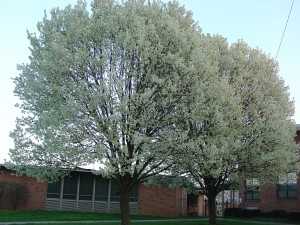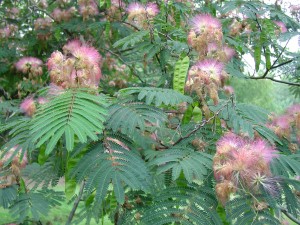Almost any time is a good time to plant trees – weather permitting. Sort through many great choices and avoid planting weak wooded species. These six tree species are generally short-lived, messy, and insect and/or disease susceptible. A few may also be designated invasive in your state.
Ornamental or Callery pears (Pyrus x calleryana (‘Bradford’ and other cvs.) are popular medium sized flowering tree. In very early spring its upright branches are blanketed with white flowers. This fast growing tree develops weak branch crotches that self-destruct in stormy or windy weather. Ornamental fruits are eaten by birds that distribute the seeds. Ornamental pears may become invasive (USDA hardiness zones 4 – 8).
Silver maples (Acer saccharinium) have a short life span and a rapid growth rate compared to other large maple species. At maturity, a typical silver maple may reach up to 60-80 feet in height. Seedling types possess weak branches which tend to break in ice storms or high winds. Some improved hybrids and cultivars such as ‘Silver Queen’ exhibit a sturdier framework.
Weeping willows (Salix spp.), including corkscrew willow (S. matsudana ‘Tortuosa’), are weak wooded. During the spring and summer, willows drop lots of twig and leaf debris. Willows are susceptible to numerous disease and insect problems (USDA Plant Hardiness Zones 4b – 8).
Siberian elms (Ulmus pumila) are very large fast growing weak-wooded tree (100 feet not uncommon). They’re exceptionally messy and litter turf and ground areas year-round. As its name hints, species is extremely cold hardy, but is not heat tolerant in Southern U.S. landscapes (USDA Plant Hardiness Zones 4 – 8).
Mimosa trees (Albizia julibrissin) develop into a lovely summer flowering small tree with pink feathery flowers and fine textured foliage. Unfortunately, these summer-flowering trees are short-lived, weak-wooded, and seeds in readily from trees many miles away (USDA hardiness zones 6 – 9).
Poplars and cottonwoods (Populus spp.) grow up to 5 feet to 8 feet a year, some species reaching 40 feet to 60 feet in height. Their weak branches spread 20 feet to 35 feet apart and are dangerous to house and autos. Leaves and branches are highly susceptible to numerous diseases and insects. In rural areas poplars are often planted in rows as windbreaks along perimeters of properties (USDA Plant Hardiness Zones 3 – 9).
In summary, most quick-growing trees are weak wooded, produce lots of seeds and/or messy fruits, root sucker badly, and are disease and insect susceptible.



 Posted in
Posted in 

Thank you, Hugh for publishing this list. I’ve planted at least 3 of them over the years, and they are “all gone”!